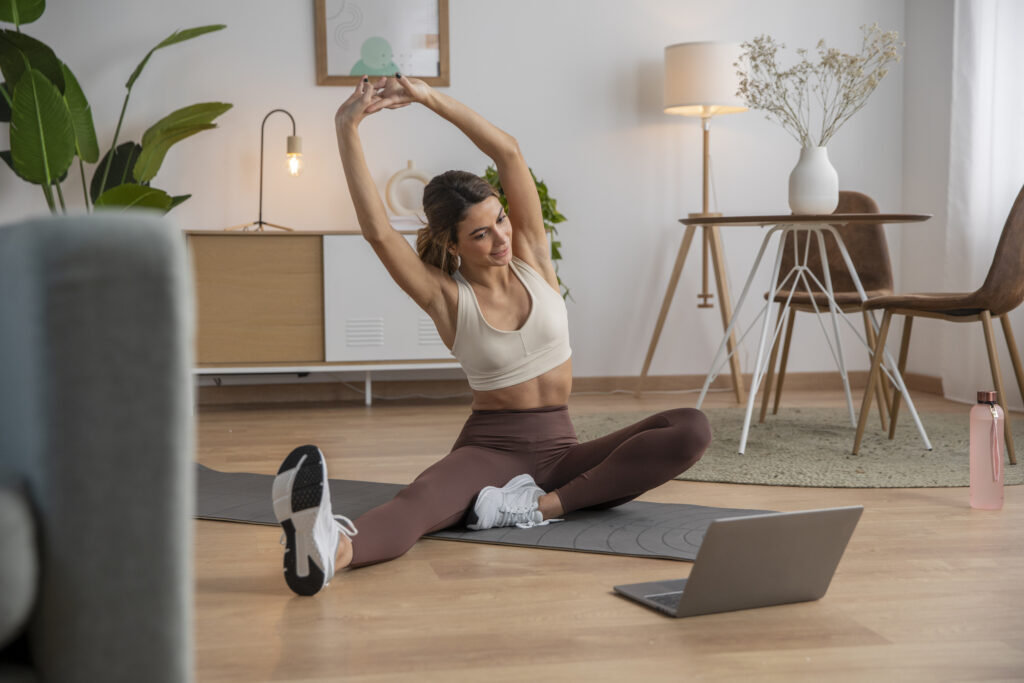You might not realize how small changes can impact your anxiety levels greatly. By understanding your triggers and integrating mindfulness practices into your daily routine, you can start to create a more peaceful environment. It's not just about managing anxiety; it's about transforming your overall mindset and well-being. As you explore different strategies, you may find that some resonate more than others. But which adjustments could truly make a lasting difference in your life?
Understanding Anxiety Triggers
Anxiety triggers can come from various sources, and recognizing them is essential for managing your feelings. You might find that specific situations, places, or even people can spark anxiety within you. For instance, crowded spaces or public speaking can elicit discomfort, causing your heart to race and your thoughts to spiral. Identifying these triggers is the first step toward transforming your anxiety.
Take a moment to reflect on your daily life. Are there certain scenarios that make you feel uneasy? Maybe it's an upcoming deadline at work or an impending social event. Once you pinpoint these triggers, you can work on strategies to cope with them.
It's also important to contemplate internal triggers, like negative thoughts or self-doubt, which can amplify your anxiety. Recognizing these patterns allows you to address them head-on.
You might also want to keep a journal. Documenting your feelings when you encounter anxiety can help you see patterns over time. This practice not only highlights your triggers but also reveals how you respond to them.
With this knowledge, you can begin to develop a personalized approach to managing your anxiety.
Mindfulness Practices for Calm
To find calm amidst anxiety, you can turn to mindfulness practices like breathing techniques and body awareness exercises.
These tools help you center your thoughts and reconnect with your body, fostering a sense of peace.
Let's explore how you can incorporate them into your daily routine.
Breathing Techniques
When you feel overwhelmed, mastering a few simple breathing techniques can be a game-changer for finding calm. One effective method is the 4-7-8 technique. Start by inhaling deeply through your nose for a count of four. Hold that breath for seven counts, then exhale slowly through your mouth for a count of eight.
Repeat this cycle four times. This exercise not only slows your heart rate but also helps clear your mind.
Another technique is diaphragmatic breathing. Sit or lie down comfortably, placing one hand on your chest and the other on your abdomen. Inhale deeply through your nose, ensuring your diaphragm (not your chest) rises. Hold for a moment, then exhale slowly through your mouth.
Aim for a steady rhythm, focusing solely on the rise and fall of your abdomen.
Finally, try box breathing. Inhale for a count of four, hold for four, exhale for four, and hold again for four. This structured method can ground you in the present moment, making it easier to manage anxious thoughts.
Body Awareness Exercises
Connecting with your body can be a powerful way to cultivate mindfulness and calm. Body awareness exercises help you tune into your physical sensations, grounding you in the present moment.
Start by finding a comfortable position, either sitting or lying down. Close your eyes and take a few deep breaths, letting your body relax with each exhale.
Next, bring your attention to your feet. Notice how they feel against the ground. Gradually move your awareness up your body, acknowledging sensations in your legs, hips, abdomen, and chest. If you notice tension or discomfort, simply observe it without judgment. Acknowledge these feelings, then breathe into those areas, allowing them to soften.
You can also practice body scans, where you mentally check in with each part of your body, from head to toe. This helps you identify areas of stress and promotes relaxation.
Try to spend at least five minutes on this exercise daily.
Creating a Supportive Environment
Creating a supportive environment is vital for managing anxiety effectively. Start by evaluating your surroundings. Is your space cluttered or chaotic? A tidy, organized space can greatly reduce feelings of overwhelm. Dedicate time to declutter and create a calming atmosphere. Use soft lighting, soothing colors, and incorporate elements that bring you peace, like plants or artwork.
Next, surround yourself with positive influences. Connect with people who uplift and support you. Share your feelings with trusted friends or family members who understand what you're going through. It's essential to have a support system in place, so don't hesitate to reach out when you need someone to talk to.
Consider setting boundaries with individuals who drain your energy or contribute to your anxiety. You deserve to have relationships that nurture your well-being.
Additionally, establish a routine that prioritizes self-care. Schedule quiet time for yourself, whether it's through meditation, reading, or engaging in a hobby you love. This dedicated time can help you recharge and find stability amidst chaos.
Finally, limit exposure to negative stimuli, whether it's social media, news, or toxic environments. Instead, focus on activities that foster positivity and joy.
Reframing Negative Thoughts
Your mindset plays an essential role in how you experience anxiety. When you find yourself caught in a cycle of negative thoughts, it can feel overwhelming. However, reframing those thoughts can be a powerful tool in transforming your anxiety. Instead of letting negative thoughts dictate your feelings, you can actively challenge and reshape them.
Start by recognizing when a negative thought arises. You might think, "I'm going to fail" or "I can't handle this." Acknowledge these thoughts without judgment, and then ask yourself: Is this thought based on facts? Often, these thoughts are exaggerated or not entirely true. By questioning their validity, you create space for a more balanced perspective.
Next, practice replacing those thoughts with positive or realistic alternatives. For example, instead of saying, "I'll never succeed," try reframing it to, "I've faced challenges before and can learn from this experience." This shift not only lightens your emotional load but also empowers you to approach situations with a clearer mind.
Additionally, visualize the worst-case scenario and consider how you'd cope if it happened. Often, the fear of failure is more intimidating than the reality. By preparing yourself mentally, you can reduce anxiety's grip.
Reframing negative thoughts takes practice, but each small adjustment can lead to significant changes in your mindset. Remember, you have the power to reshape your thoughts, and with time, you'll notice a difference in how you handle anxiety.
Incorporating Healthy Routines
Reframing negative thoughts is just one part of managing anxiety; incorporating healthy routines can further enhance your well-being. When you establish a consistent routine, you create a sense of stability that can help ground you during anxious moments.
Here are a few healthy habits you can incorporate into your daily life:
- Regular Exercise: Aim for at least 30 minutes of physical activity most days. This boosts endorphins, which can elevate your mood and reduce stress.
- Balanced Nutrition: Eating a well-rounded diet rich in fruits, vegetables, whole grains, and lean proteins can improve your overall mental health. Avoid excessive caffeine and sugar, as they can heighten anxiety.
- Mindfulness Practices: Incorporating meditation or deep breathing exercises into your day can help you stay present and calm. Just a few minutes can make a significant difference in your anxiety levels.
- Consistent Sleep Schedule: Prioritize getting 7-9 hours of sleep each night. A regular sleep routine can enhance your focus and resilience to stress.
- Social Connections: Engaging with friends or loved ones provides emotional support. Make time for social activities, even if it's just a quick phone call.
Seeking Professional Guidance
When you're ready to tackle your anxiety, seeking professional guidance can be a game changer.
Finding the right therapist and understanding the benefits of different therapeutic approaches can set you on a path to healing.
Let's explore how to choose a therapist and what to expect from your therapy sessions.
Choosing the Right Therapist
Finding the right therapist can feel like a challenging task, but it's an essential step in managing anxiety effectively. You want someone who understands your unique experiences and can guide you through your journey.
To help you in your search, consider the following factors:
- Specialization: Look for a therapist who specializes in anxiety disorders or the specific issues you're facing.
- Approach: Different therapists use various methods, such as cognitive-behavioral therapy or mindfulness techniques. Research their approaches to find one that resonates with you.
- Credentials: Check their qualifications and licensure; a licensed professional is more likely to have the training needed to help.
- Comfort Level: You should feel at ease with your therapist. Trust your instincts about whether you can open up to them.
- Availability: Consider their schedule and location. You'll want a therapist whose availability aligns with yours, making it easier to attend sessions regularly.
Benefits of Therapy Sessions
Therapy sessions offer a safe space where you can unpack your anxiety with someone trained to help. When you seek professional guidance, you gain access to tools and strategies tailored specifically for you. A therapist can help you identify the root causes of your anxiety, fostering a deeper understanding of your feelings and behaviors. This process often leads to increased self-awareness, empowering you to manage your emotions more effectively.
Moreover, therapy provides you with an opportunity to express yourself freely without judgment. Sharing your thoughts and experiences can be incredibly liberating, allowing you to release pent-up emotions that may be contributing to your anxiety. You'll also learn coping mechanisms that can be applied in daily life, transforming overwhelming moments into manageable ones.
Additionally, having a dedicated time and space for reflection can enhance your overall mental well-being. Regular sessions create a consistent routine, helping you develop resilience over time.
Types of Therapeutic Approaches
Several effective therapeutic approaches can help you navigate anxiety and find relief. By seeking professional guidance, you can explore various methods tailored to your needs. Here are some popular options:
- Cognitive Behavioral Therapy (CBT): This approach focuses on identifying and changing negative thought patterns that contribute to your anxiety.
- Mindfulness-Based Therapy: Incorporating mindfulness practices helps you stay present and reduce anxiety by enhancing your awareness of thoughts and feelings.
- Exposure Therapy: Gradually facing your fears in a controlled environment can help desensitize you to anxiety-provoking situations.
- Acceptance and Commitment Therapy (ACT): This method encourages you to accept your thoughts and feelings rather than fight them, promoting psychological flexibility.
- Eye Movement Desensitization and Reprocessing (EMDR): Often used for trauma, EMDR helps process distressing memories that may contribute to your anxiety.
Each of these approaches offers unique strategies to address anxiety. By working with a qualified therapist, you can determine which method resonates with you, allowing you to develop healthier coping mechanisms and ultimately transform your relationship with anxiety.
Conclusion
By recognizing your anxiety triggers and incorporating mindfulness practices, you can cultivate a sense of calm in your daily life. Creating a supportive environment and reframing negative thoughts will further enhance your emotional well-being. Don't forget to establish healthy routines that include exercise, nutrition, and quality sleep. Remember, small changes can lead to significant improvements. If needed, seeking professional guidance can provide additional support on your journey to transforming anxiety into peace of mind.

